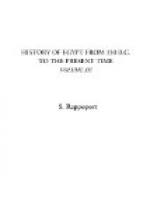Another famous German who was interested in the study of Egyptology was Baron Christian Bunsen (1791-1867). From early youth he showed the instincts of a scholar, but was prevented for many years from leading a scholar’s life, owing to his active duties in the diplomatic service for Prussia at Rome and London. During the years 1848—67, Bunsen brought out the famous work called “Egypt’s Place in Universal History,” which Brugsch deemed to have contributed more than any other work in popularising the subject of Egyptology.
Heinrich Carl Brugsch was born at Berlin in 1827 and died there in 1894. Like Bunsen, he was a diplomatist and a scholar. He entered the service of the Egyptian government, and merited the titles of bey and subsequently of pasha. He became known as one of the foremost of Egyptologists, and was the greatest authority of his day on Egyptian writing. He wrote a work of standard authority, translated into English under the title of “The History of Egypt under the Pharaohs.” The chronology of Egypt now in use is still based upon the system created by Brugsch, which, though confessedly artificial, nevertheless is able to meet the difficulties of the subject better than any other yet devised.
Among distinguished German Egyptologists must be mentioned Georg Moritz Ebers (1839-96). He is best known by his far-famed novels, whose subjects are taken from the history of ancient Egypt, perhaps the most popular being “An Egyptian Princess.” Besides these popular novels and a valuable description of Egypt, Ebers also made personal explorations in the country, and discovered at Thebes the great medical papyrus, which is called the Papyrus Ebers. This remarkable document, to which he devoted so much labour, is our chief source of information regarding the practice of medicine as it existed, and would alone keep the name of Ebers alive among Egyptologists.
The leading German Egyptologist of to-day is Dr. Adolf Erman, who was born at Berlin in 1854. He is the worthy successor to Brugsch in the chair of Egyptology at the University of Berlin, and is director of the Berlin Egyptian Museum. His writings have had to do mainly with grammatical and literary investigations. His editions of the “Romances of Old Egypt” are models of scholarly interpretation. They give the original hieratic text, with translation into Egyptian hieroglyphics, into Latin and into German. Doctor Erman has not, however, confined his labours to this strictly scholarly type of work, but has also written a distinctly popular book on the life of the ancient Egyptians, which is the most complete work that has appeared since the writings of Wilkinson.
The memorable speech of Erman, delivered on the occasion of his election as a member of the Berlin Academy, sets forth clearly the progress made in the science of Egyptology and present-day tendencies. On that occasion he said:




